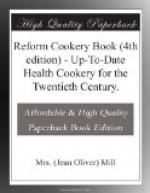But joking apart, there is a growing tendency to get as far away as we can from their origin in the serving of meat dishes. The old-time huge joints, trussed hares, whole sucking pigs, &c., are fast vanishing from our tables, and the smart chef exerts himself to produce as many recherche and mysterious little made dishes as possible. Not a few of these are quite innocent of meat, indeed, that is the complaint urged against them by those who believe that in flesh only can we have proper sustenance. But little research is needed, however, to show that apart from flesh foods there are immense and only partially developed resources in the shape of cereals, pulses, nuts, &c., and, it is to these that we must look for our staple solid foods. In a small work like this it is impossible to do much more than indicate the lines upon which to go, but I shall try to give as many typical dishes as I can, and to suggest, rather than detail, variations and adaptations.
We must first study very briefly the various food elements, and learn the most wholesome and suitable combination of these. In an ordinary three-course dinner we must arrange to have a savoury that will fitly follow the soup and precede the sweets. Thus, if we have a light, clear, or white soup, we shall want a fairly substantial savoury, and if the soup has been rather satisfying it must be followed by a lighter course.
The lightest savouries are prepared mostly from starch foods, as rice, macaroni, &c., while for the richer and more substantial we have recourse to peas, beans, lentils, and nuts.
The first set of savouries given are of the lighter description, and are well suited to take the place of the fish course at dinner.
LIGHT SAVOURIES.
Fillets of Mock Sole.
Bring to boil 1/2 pint milk and stir in 2 ozs. ground rice or 3 ozs. flaked rice. Add 1 oz. butter, teaspoonful grated onion, and a pinch of mace. Add also three large tablespoonfuls of potato which has been put through a masher or sieve, mix, and let all cook for 10 to 20 minutes. As the mixture should be fairly stiff this can best be done in a steamer or double boiler. When removed from the fire add 1 egg and 1 yolk well beaten. Mix thoroughly and turn out on flat dish not quite 1/2 inch thick, and allow to get quite cold. Divide into fillet-shaped pieces, brush over with white of egg beaten up, toss in fine bread crumbs and fry in deep smoking-hot fat. Drain, and serve very hot, garnished with thin half or quarter slices of lemon, and hand round Dutch sauce in tureen.
Fillets of Artichoke.
Boil some Jerusalem Artichokes till tender, but not too soft, cut in neat slices, and egg, crumb, and fry as above.
Chinese Artichokes.
Salsify, Scorzonera, &c., may be done in same way. Serve with Dutch or tomato sauce. A variety is made by simply boiling or steaming in milk and water. Drain, and serve with parsley or other sauce poured over.




